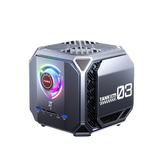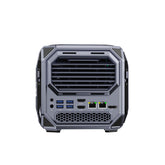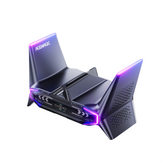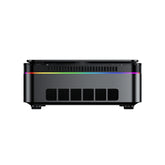Intel Core i7 vs i9: A Comprehensive Comparison for 2025

The Intel Core processor lineup has become synonymous with high-performance computing since its debut, offering a range of options from entry-level to top-tier models. Among them, the Core i7 and Core i9 are the two most powerful processors, designed for users with demanding computing needs. Whether you're a gamer, video editor, or professional user, the impressive performance of both the i7 and i9 processors can meet the demands for speed and efficiency in complex tasks.
However, with the release of the Intel Core i9 processors, their exceptional performance comes at a higher price. This leads to a common question: is the i9 truly worth its extra cost? In certain scenarios, is the i7 sufficient, or are the enhancements in the i9 something every user can fully take advantage of? By comparing the differences between the two, we can better help you make the most informed decision between Intel i7 vs i9, and determine which processor is the right fit for your needs.
1. Core Parameter Comparison
When choosing a processor, key factors such as core and thread count, cache size, base and boost clock speeds, and memory and graphics support all play a significant role in performance. Let’s compare the Intel i7 vs i9 across these key aspects to help you better understand the differences.
Core and Thread Count
Intel Core i9 processors typically come with more cores and threads, making them ideal for multitasking and high-load applications. The i9 models can go up to 16 cores or even 24 cores, with corresponding increases in thread count, which allows for superior performance in multi-threaded tasks like video editing, 3D rendering, and virtualization. For example, the Intel Core i9-14900K has 24 cores and 48 threads, enabling it to handle more parallel operations in demanding tasks.
On the other hand, Intel Core i7 processors typically feature fewer cores, usually ranging from 8 to 12 cores. This makes them well-suited for everyday multitasking, gaming, and general use. While i7 processors also support multi-threading, their performance in large-scale parallel workloads generally lags behind that of i9 processors.
| Processor Model | Cores | Threads |
|---|---|---|
| Intel Core i9-14900K | 24 | 48 |
| Intel Core i7-13700K | 16 | 24 |
Cache Size
Cache is a key factor in determining processor speed as it affects data access and retrieval efficiency. i9 processors typically come with larger cache sizes, helping speed up data processing. For instance, the Intel Core i9-14900K has 36MB of Intel Smart Cache, whereas i7 processors usually have a cache size between 24MB and 30MB. For example, the Intel Core i7-13700K has a cache of 30MB. A larger cache allows the i9 to process a higher volume of data requests more quickly, leading to better overall performance.
Clock Speed and Overclocking
The clock speed determines how much processing a processor can handle per second, while overclocking is another way to boost a processor's performance. i9 processors generally feature higher base clock speeds and often support more aggressive overclocking. For instance, the Intel Core i9-14900K has a base clock speed of 3.0GHz, with a max overclocking potential of up to 5.8GHz, making it ideal for demanding computational tasks and high-load applications.
In contrast, i7 processors tend to have lower base clock speeds. For example, the Intel Core i7-13700K has a base clock of 2.66GHz. While it does offer some overclocking potential, it generally does not reach the overclocking headroom of the i9. For most users, the i7's performance is more than enough for everyday tasks and gaming needs, while the i9 is better suited for professional users with extreme performance demands.
| Processor Model | Base Clock | Max Overclock |
|---|---|---|
| Intel Core i9-14900K | 3.0GHz | 5.8GHz |
| Intel Core i7-13700K | 2.66GHz | 5.4GHz |
Memory and Graphics Support
In terms of memory, i9 processors typically support larger memory capacities, which is crucial for applications that require extensive memory usage, such as video editing, CAD design, and virtualization. For instance, the Intel Core i9-14900K supports up to 64GB of memory, while the Intel Core i7-13700K supports a maximum of 32GB or lower. For workloads that require frequent large memory operations, the i9 provides a higher upper limit.
Regarding graphics, i9 processors generally come with integrated graphics (e.g., Intel UHD Graphics 770). While the integrated graphics are not as powerful as dedicated GPUs, they are sufficient for everyday office tasks or light gaming. In contrast, many i7 processors—especially "F" models—lack integrated graphics, which means you’ll need to pair them with a dedicated GPU for graphics processing.
| Processor Model | Max Memory Support | Integrated Graphics |
|---|---|---|
| Intel Core i9-14900K | 64GB | Intel UHD 770 |
| Intel Core i7-13700K | 32GB | No Integrated GPU |
2. Performance Difference in Real-World Usage
When choosing between the Intel Core i7 and i9, understanding their performance differences in real-world scenarios is crucial. While the i9 has superior hardware on paper, the actual performance difference depends heavily on the type of tasks you're running. Here’s a comparison of how the two processors perform in common use cases.
Multi-threaded Tasks (e.g., Video Rendering, 3D Modeling)
For tasks that require significant parallel computation, the i9 shows a clear advantage. Thanks to its higher core and thread count, the i9 excels in multi-threaded performance. For example, the Intel Core i9-14900K, with 24 cores and 48 threads, can efficiently handle video rendering, 3D modeling, and other tasks that require parallel processing. In these tasks, the i9 generally offers a 30%-40% performance boost over the i7.
Benchmark tests show that the i9 outperforms the i7 in video rendering (such as with Adobe Premiere Pro or DaVinci Resolve) and 3D modeling (e.g., Blender rendering). For instance, the i9-14900K is approximately 40% faster than the i7-13700K in Blender rendering tests, meaning the i9 can save significant time on heavy workloads.
| Processor Model | Cores | Threads | Multi-threaded Performance Boost |
|---|---|---|---|
| Intel Core i9-14900K | 24 | 48 | +30%-40% |
| Intel Core i7-13700K | 16 | 24 | Benchmark |
Gaming Performance
For most games, especially those that don't fully utilize multi-core processors, single-core performance is often the key factor affecting frame rates. While the i9 holds a slight advantage over the i7 in raw performance, the difference in gaming performance is generally not as pronounced as in multi-threaded tasks. Many modern games still rely heavily on strong single-core performance, and the i7's single-core performance is already exceptional.
For example, when comparing the Intel Core i9-14900K and i7-13700K, even though the i9 has a slight single-core performance edge, the i7’s higher clock speeds and better optimization for gaming support often result in frame rates that are very close to the i9's performance. In fact, in some cases, the i7 may outperform the i9 due to superior game-specific optimizations. At 1080p resolution, the difference in performance between the two is often within 5%, which is negligible for most gamers.
| Processor Model | Single-core Performance | Gaming Frame Rate Difference |
|---|---|---|
| Intel Core i9-14900K | High | Slightly ahead |
| Intel Core i7-13700K | High | On par with i9 |
Power Consumption and Cooling
The i9 processors generally have higher power consumption, especially under heavy loads (such as video rendering, gaming, or computationally intense applications). For example, the Intel Core i9-14900K can draw up to 125W or more under full load. Because of this, i9 processors require more advanced cooling solutions to keep temperatures in check and ensure stable performance.
In contrast, the i7 processors tend to have lower power consumption. The Intel Core i7-13700K, for example, typically consumes around 105W, and while its power draw increases under heavy workloads, it still demands less cooling than the i9. For most users, the i7’s cooling requirements are simpler and more affordable, often not needing high-end cooling solutions.
| Processor Model | Power Consumption | Cooling Requirements |
|---|---|---|
| Intel Core i9-14900K | 125W | High-end cooling system |
| Intel Core i7-13700K | 105W | Mid-range cooling system |
3. Use Case Analysis
When choosing between the Intel Core i7 vs i9, performance differences are important, but it's equally crucial to consider your specific use case. Your needs and budget will directly influence which processor is more suitable for you. Here’s a breakdown of processor recommendations based on various use cases.
Recommended for i9 Users
The Intel Core i9 is perfect for users who need powerful multi-tasking capabilities, high-load computation, or professional content creation. For data scientists, video editors, 3D modelers, and animation designers, the i9's higher core and thread count, along with its ability to handle parallel computing, make it ideal for heavy workloads.

ACEMAGIC S3A Mini PC
The ACEMAGIC TANK03 12900H Pro is a powerhouse mini PC featuring the Intel® Core™ i9-12900H processor and NVIDIA GeForce RTX 4060 GPU, delivering exceptional performance for gaming, AI, and professional tasks.
Moreover, the i9 is ideal for tasks that require extensive parallel computation, such as video rendering, audio production, large-scale data analysis, and machine learning. For these heavy multi-tasking and computationally complex applications, the i9 provides a significant performance boost, shortening work time and improving efficiency. For example, the i9-14900K, with 24 cores and 48 threads, handles multiple professional applications simultaneously without any performance lag.
Recommended for i7 Users
If you're a mainstream gamer, office worker, or someone who needs light design work, the Intel Core i7 is a more appropriate choice. The i7 already offers ample single-core and multi-core performance for most mainstream games, everyday applications, and office software. For example, the i7-13700K, with its strong single-core performance, provides smooth frame rates, even meeting the requirements for 144Hz or higher refresh rate monitors.
For light design tasks such as image editing, web design, or other creative work, the i7’s performance is more than sufficient for most designers and developers. In workstation applications, the i7 efficiently handles daily office tasks, video conferencing, and document editing, all while being more competitively priced.
Price-to-Performance Consideration
Although the i9 offers better performance than the i7, the price difference is considerable. The i9 is typically 30%-50% more expensive than the i7, and this price gap should be weighed according to your budget. If you have a higher budget and your work involves heavy computational tasks, investing in the i9 is worthwhile. The performance gains will be evident in long-term, high-intensity tasks.
However, for budget-conscious users or those mainly gaming, performing everyday office work, or handling light design needs, the i7 is sufficient for most tasks and comes at a more affordable price point. In such cases, the i7 offers a better balance of performance and cost.
| Recommended Processor | Use Case | Price-to-Performance |
|---|---|---|
| Intel i9 | Professional content creators, data scientists, heavy multi-tasking users | Significant performance boost, ideal for high-load tasks |
| Intel i7 | Mainstream gamers, office workers, light design needs | Budget-friendly, meets most needs |
4. Common Misconceptions and Considerations
When choosing between the Intel Core i7 vs i9, users often fall into several misconceptions that may lead to unnecessary spending or selecting the wrong processor. Here are some common misunderstandings and important things to consider to help you make a more informed decision.
Generational Difference
The Gap Between i9 and i7 in the Same Generation May Be Smaller Than Between Generations
Many people assume that the i9 is always more powerful than the i7, but this isn’t always the case. Processor performance depends not only on the number of cores and threads but also on the processor generation (e.g., 10th gen, 12th gen). The performance gap between an i9 and i7 within the same generation may be smaller than between processors of different generations. For example, a 12th-gen i7 may outperform a 10th-gen i9 in multi-core performance, despite the 10th-gen i9 having a higher base clock. When choosing a processor, it’s best to compare products within the same generation rather than making decisions based solely on the generation number.
Hyper-Threading Over-Optimization
Some Games Don’t Benefit from Hyper-Threading, and i9 May Not Be More Stable Than i7
While the i9 processor’s multi-core, multi-thread performance is impressive, not all applications benefit from these extra threads. Particularly in gaming, many games rely more on single-core performance, and Hyper-Threading doesn't significantly boost frame rates. In fact, some games don’t handle Hyper-Threading well, and it may even cause the i9 to be less stable than the i7. For instance, in some poorly optimized games, the multi-threading on an i9 may result in negative performance, making the i7 a more stable and smoother experience. Therefore, gamers might find that the i7 offers a more consistent and better gaming experience.
Cooling and Motherboard Compatibility
Since the i9 typically has higher power consumption than the i7, it requires more advanced cooling systems and motherboard compatibility. The i9 often needs to be paired with higher-end motherboards (such as Z-series motherboards) and more powerful cooling solutions (like high-end liquid cooling or high-wattage air cooling) to ensure stable performance. Without proper cooling, the i9 may throttle due to overheating, leading to a drop in performance. Additionally, because the i9 has higher requirements, the overall build cost may increase significantly, even being more than double that of an i7. Therefore, when choosing an i9, the cost of the motherboard and cooling solution must also be considered, in addition to the cost of the processor itself.
5. Buying Guide
Choosing the right Intel Core i7 or i9 processor is not just about looking at the numbers. Various factors such as your usage scenarios, budget, hardware compatibility, and future upgrade plans will all influence your final decision. Here are some buying tips to help you make an informed choice based on your needs.
Clarify Your Needs
Before purchasing an i7 or i9, the first step is to clearly define the primary applications or games you'll be using. Do you need to handle multitasking, large files, or high-load applications? For tasks like video editing, 3D modeling, virtualization, or scientific computing, which often rely on strong multi-core performance, the i9’s multi-core advantage can significantly boost productivity. However, for everyday office tasks, light design work, or most mainstream gaming, the i7 is more than enough and offers better value for money.
It's a good idea to list the software or games you frequently use and check whether they require high multi-core performance. For example, content creation tools like Adobe Premiere, AutoCAD, and Blender are more dependent on multi-core processors, while games like PUBG and League of Legends rely more on single-core performance, where the i7 performs well enough.
Pay Attention to Model Suffixes (e.g., K, F, T)
The suffixes in Intel processor models (such as K, F, T) are crucial in helping you select the right CPU. Understanding these suffixes can guide you to the most suitable processor for your needs.
- K Series: Supports overclocking, ideal for users who need extreme performance and tuning. If you’re interested in overclocking, the K-series (e.g., i9-13900K) allows you to unlock the full potential of the processor for higher performance.
- F Series: Lacks integrated graphics, making it suitable for users who already have a discrete GPU. If you're using a high-performance graphics card (like the RTX series), choosing an F-series processor (e.g., i9-13900F) can save you the cost of integrated graphics.
- T Series: Has lower power consumption, ideal for lightweight machines or small PC systems that require efficiency, such as HTPCs or compact servers, typically seen in low-power scenarios.
- E Series: Designed for embedded systems or low-power scenarios, suited for extreme energy-saving needs or specific custom applications.
Future Upgrade Potential
If you plan to upgrade your hardware in the future, the i9’s platform compatibility may offer you more room for growth. For example, the i9 usually supports more memory and higher bus frequencies, providing better scalability for future upgrades. This means you can enjoy a longer lifecycle and performance improvements without needing to replace your motherboard.
For users with long-term usage plans, the i9 not only meets current needs but will also be ready for upgrades over the next few years. On the other hand, if your needs are limited to your current usage scenarios, the i7 is already sufficient in terms of performance and offers a more budget-friendly option.
6. Conclusion: i7 or i9? The Answer Depends on Your Workflow
When choosing between the Intel Core i7 vs i9 processors, the most important factor is not blindly chasing the flagship model, but making an informed decision based on your specific needs. The i9 undoubtedly outperforms the i7 in terms of core count, cache, and clock speeds, making it suitable for professionals who require high performance and multitasking capabilities, such as content creators, data scientists, and high-end gamers. On the other hand, the i7 offers better value for money and enough single-core performance to handle most everyday office tasks, mainstream games, and light content creation.
In short, the key to choosing a processor is being driven by your needs. If your workload demands ultra-high multitasking and parallel computing power, the i9 is undoubtedly the better choice. However, if you need an efficient and stable work machine, the i7 will more than meet your requirements, and you'll save unnecessary budget.
Don’t chase the top-tier hardware—optimize your choice based on your workflow, which is the most rational approach.
Related articles
Amd Ryzen 5 vs Intel i5: Differences & How to Choose
Intel Celeron Processor vs Pentium: Key Differences and Best Use Cases
Intel Core Ultra 7 vs i7: Which Processor Is Right for You?
References and Further Reading
[1] Intel® Core™ i9 Prozessor 14900K [Cited 2025 February 26] Available at: Link
[2] Intel® Core™ i7-13700K Processor [Cited 2025 February 26] Available at: Link
[3] UserBenchmark: Intel Core i7-13700K vs i9-14900K [Cited 2025 February 26] Available at: Link







Leave a comment
Please note, comments need to be approved before they are published.